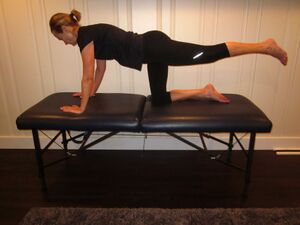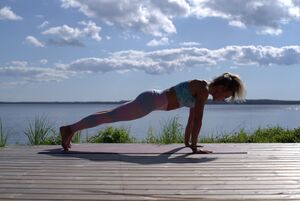Lumbar Multifidus
Original Editor - Lucinda hampton
Top Contributors - Lucinda hampton and Kim Jackson
Introduction[edit | edit source]
The Multifidus muscle is a series of small, triangular muscular and tendinous bundles located on either side of the spinal column, where they fill the groove between the transverse and spinous processes of the vertebrae. [1][2]
These fasciculi ascend two to four (or sometimes five) vertebral segments before ending on a spinous process. Multifidi muscles insert onto all the vertebrae except the atlas. [2]
Multifidus is part of the deep Intrinsic back muscles, known as the transversospinales, which consist of 3 major subgroups: Semispinalis, Multifidus, and Rotatores. They are the thickest muscles in the transversospinal group, and are shorter than semispinalis, but longer than rotatores[3].
Origin, Insertion, Nerve Supply[edit | edit source]
Origin: Posterior sacrum, posterior superior iliac spine, aponeurosis of the erector spinae, sacroiliac ligament, mammillary processes of the lumbar vertebrae, transverse processes of T1-3, articular processes of C4-C7.
Insertion: The multifidus muscle fibers pass upwards and medially to insert onto the spinous process of each vertebrae in the spinal column, except for the very top cervical vertebrae (C1)[4].
Nerve Supply: The intrinsic/deep back primarily nerve supply arises from dorsal rami of the spinal nerves.. The medial branches of dorsal rami of spinal nerves specifically supply multifidus.[3]
Actions[edit | edit source]
All of the transversospinalis muscles, which multifidus is one of, are extensors of the back and neck.
- The multifidus and semispinalis muscle group has also been identified as rotators by some texts and refuted in others.[4]
- Evidence points to the multifidus muscle being continuously active in upright postures. In fact, the multifidus is probably active in all anti-gravity activity.[5]
- The multifidus stabilizes the vertebrae as the spine moves. It is thought that the unique design of the multifidus endows it with extra strength.[2]
- When the oblique abdominal muscles contract to produce trunk rotation, some flexion of the trunk also occurs. The multifidus muscles oppose this trunk flexion maintaining a pure axial rotation, thus acting as stabilizers during trunk rotation.[2]
Physiotherapy[edit | edit source]
The multifidus is one of the important core muscles stabilizers, playing an important role in the static and dynamic spinal stability.
- Core stabilization programs are suggested to increase multifidus cross section area and decrease low back pain, weakness in the multifidus muscle being associated with low back pain[6] [7]
- Core muscles are noted for their contribution to spinal stability and are important in home exercise programs given to people with low back pain in physical therapy.
Investigators have categorized multifidus fiber types by layers:
- The deepest layer appears to contributes more strength and stability to the spine than do superficial layers. Possibly because the deep layer only spans 2 vertebral segments (as opposed to up to 4 with the other layers). The resulting shorter "excursion" of the deep layer of the multifidus means that when the muscle contracts, it contributes to more compression type motion at the spinal joint it affects compared to other back extensor muscles and the more superficial layers of the multifidus.[1]
References[edit | edit source]
- ↑ 1.0 1.1 Very well health Role of the Multifidus Muscle Available: https://www.verywellhealth.com/multifidus-muscle-296470 (accessed 29.1.2022)
- ↑ 2.0 2.1 2.2 2.3 Darby S, Cramer G. Clinical anatomy of the spine, spinal cord, and ANS. St. Louis, Mo.: Elsevier. 2014.Available: https://www.sciencedirect.com/book/9780323079549/clinical-anatomy-of-the-spine-spinal-cord-and-ans (accessed 29.1.2022)
- ↑ 3.0 3.1 Ken Hub Mulrifidius Available: https://www.kenhub.com/en/library/anatomy/multifidus-muscle(accessed 29.1.2022)
- ↑ 4.0 4.1 Radiopedia Transversospinalis Available:https://radiopaedia.org/articles/transversospinalis-muscle-group?lang=us (accessed 29.1.2022)
- ↑ Chaitow L, DeLany J. Clinical Application of Neuromuscular Techniques, Volume 2 E-Book: The Lower Body. Elsevier Health Sciences; 2011 Jul 5.Available:https://www.sciencedirect.com/book/9780443068157/clinical-application-of-neuromuscular-techniques (accessed 29.1.2022)
- ↑ Zheng Y, Ke S, Lin C, Li X, Liu C, Wu Y, Xin W, Ma C, Wu S. Effect of Core Stability Training Monitored by Rehabilitative Ultrasound Image and Surface Electromyogram in Local Core Muscles of Healthy People. Pain Research and Management. 2019;2019. Available:https://www.ncbi.nlm.nih.gov/pmc/articles/PMC6612403/ (accessed 29.1.2022)
- ↑ Goubert D, Van Oosterwijck J, Meeus M, Danneels L. Structural changes of lumbar muscles in non-specific low back pain. Pain physician. 2016;19(7):E985-99.











